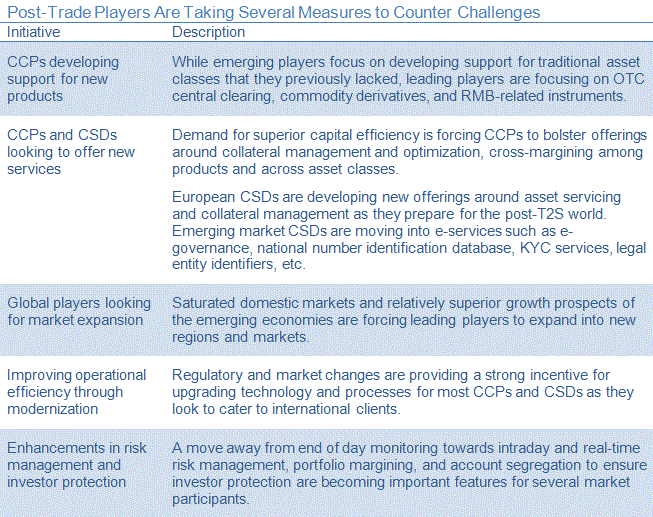Challenging Times for the Post-Trade Industry: Improving Efficiency and Achieving Stability Amidst Growing Complexity
Abstract
Celent has released a new report titled Challenging Times for the Post-Trade Industry: Improving Efficiency and Achieving Stability Amidst Growing Complexity. The report is authored by Senior Analyst Dr. Anshuman Jaswal and Analyst Arin Ray, both with Celent’s Securities and Investments practice.
This research is part of Celent’s ongoing coverage of the post-trade industry and was commissioned by NASDAQ OMX, while Celent kept full editorial control.
In the last few years, particularly in the aftermath of the financial crisis of 2008, the post-trade segment has been receiving much greater attention due to a number of factors, including the growing focus on market safety and stability, the explosion of asset classes, the need for harmonization and standardization, and the focus on modernization and improving efficiency.
In the report, Celent analyzes the current global, regional, and local trends impacting the central counterparties (CCPs) and central securities depositories (CSDs), and discusses how the key players are gearing up to combat challenges and position themselves for the future.
Celent identified 12 key markets across the globe for this analysis, including the US, the UK, Germany, Czech Republic, Japan, Australia, Hong Kong, China, India, Brazil, Mexico, and Chile. Celent dives deep and analyzes local trends by discussing country-specific issues for each of the 12 countries under consideration.
The regulatory environment is the dominant force impacting post-trade industry players, as regulators have heightened their focus on managing systemic risk and ensuring market safety and stability in the aftermath of the financial crisis. Added to these are market infrastructure initiatives, such as Europe’s Target2-Securities (T2S), shortening of settlement cycles, and CPMI-IOSCO’s FPMI guidelines.
“At times there is a lack of clarity and coordination among regulators in different jurisdictions. This results in lack of synchronization and standardization of some of the regulations, making the task of responding to the changes more difficult,” says Ray.

To implement these changes, CCPs and CSDs need to carefully consider their technology investments and sourcing strategies.
“We expect large post-trade service providers to continue to undertake a significant proportion of in-house technology development,” says Jaswal. “However, the relevance of third party systems is rising, as they allow CCPs and CSDs to meet their IT requirements quicker and often much cheaper. In particular, tier 2 and tier 3 players who lack the wherewithal to build in-house capabilities are finding this a worthy proposition.”
The report begins with a discussion on the current state of the global post-trade industry, analyzing organizational structures, ownership, products, and service offerings. It then discusses the challenges faced by the players at a global and regional level and plans to counter and adapt to the changes.
A separate chapter discusses the approach to technology and its sourcing strategy by industry participants and how it is likely to evolve. The report concludes with Celent’s views about the future of the post-trade industry.
The report is also available from Nasdaq.

